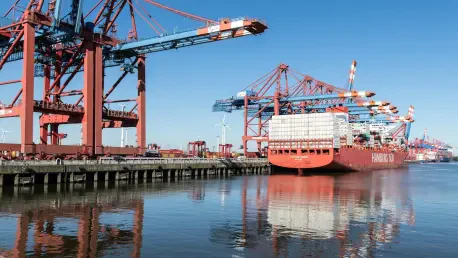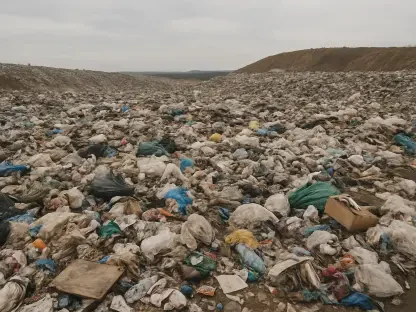Setting the Stage: A Regulatory Shockwave in Recycling Markets
In a landscape already fraught with volatility, China’s latest restrictions on recycled pulp imports have emerged as a defining challenge for the global old corrugated cardboard (OCC) market, shaking up supply chains and trade dynamics. Announced in late 2024, these rules mandate importers to specify whether pulp is processed via dry or wet methods and permit on-site shipment inspections, targeting the high contamination levels in dry-milled pulp. This policy has reverberated across supply chains, affecting pricing, production, and trade flows from the U.S. to Southeast Asia. The significance of this regulatory shift lies in its potential to redefine market dynamics at a time when sustainability pressures are intensifying. This analysis aims to dissect the immediate impacts, uncover underlying trends, and project future trajectories for industry stakeholders navigating this unexpected disruption.
Deep Dive into Market Dynamics and Projections
Unraveling the Policy’s Immediate Impact on OCC Pricing
China’s new import restrictions have injected a wave of uncertainty into the OCC market, triggering an immediate downturn in prices. As importers and suppliers grapple with ambiguous enforcement guidelines, pulpers have capitalized on the situation to negotiate lower costs, exacerbating price volatility in a commodity already known for wild swings. Market participants are hesitant to commit to long-term contracts, fearing non-compliance penalties or shipment rejections. This cautious stance has led to a temporary oversupply in certain regions, further depressing values and highlighting the fragility of current market structures.
The ripple effects are evident in trading hubs worldwide, where speculators are left with unplaced cargo, adding to the financial strain. Data from industry reports suggest that OCC prices, which have fluctuated dramatically in recent years, could face sustained downward pressure if clarity on inspections remains elusive. For businesses reliant on stable pricing, this uncertainty poses a critical risk, necessitating adaptive strategies to mitigate losses in the short term while bracing for potential long-term shifts in demand patterns.
Dry vs. Wet Processing: A Pivot Point for Quality Standards
At the heart of China’s policy lies a clear distinction between dry and wet processing methods for recycled pulp, with a marked preference for the latter due to its lower contamination risks. Dry-milled pulp, often derived from OCC, frequently contains plastic and metal fragments because of minimal screening, posing both quality and health concerns such as bacterial contamination. Wet-pulped bales, on the other hand, benefit from high-temperature sterilization during processing, aligning with China’s push for cleaner imports and driving a surge in demand for this method since the policy’s announcement.
This shift toward wet processing, while addressing environmental goals, introduces cost challenges for Chinese paper producers who may face higher raw material expenses. The transition also disrupts established supply chains, particularly for dry pulpers who lack the infrastructure to pivot quickly. Projections indicate that a sustained preference for wet-pulped materials could reshape production priorities globally, potentially increasing operational costs by 10-15% for non-compliant facilities over the next two years, compelling investments in technology upgrades to meet stringent standards.
Regional Fallout: Southeast Asia Caught in the Crossfire
Southeast Asian nations, key players in processing OCC into recycled pulp for China, are experiencing significant disruptions due to the new rules. Countries like Thailand, heavily reliant on dry pulping, have seen production halts and cargo diversions as facilities await regulatory clarity. This mirrors historical patterns where past Chinese policies redirected material flows, often overwhelming regional capacities and prompting local import bans. The current scenario adds logistical strain, with redirected shipments creating bottlenecks in supply chains already stretched thin.
Beyond immediate production challenges, the policy underscores disparities in regional processing capabilities. Nations with advanced wet pulping infrastructure stand to gain market share, while others risk exclusion unless rapid adaptations are made. Analysts predict that over the next 12-18 months, investment in wet processing facilities in Southeast Asia could rise sharply, though this will likely be accompanied by short-term economic pain for smaller operators unable to fund such transitions, potentially reshaping the competitive landscape.
Historical Context: Building on a Legacy of Environmental Controls
To understand the full scope of this market disruption, it’s crucial to view China’s latest move within the broader arc of its environmental policies. Over the past decade, initiatives like the Green Fence and National Sword reclassified OCC and mixed paper as waste, slashing direct imports and pushing the industry toward recycled pulp as a workaround. Trade in this material skyrocketed in volume from 2025 onward, with a significant portion processed via dry methods, a practice now under scrutiny with the current restrictions.
This historical progression reveals a consistent pattern of tightening controls, with each policy layer adding complexity to global recycling markets. The focus on pulp quality marks a nuanced evolution, targeting a specific segment of the supply chain rather than broad import bans. Looking ahead, industry observers anticipate further regulatory tightening, potentially culminating in a complete phase-out of dry pulping if enforcement proves effective, a scenario that could redefine sourcing strategies for years to come.
Future Outlook: Trends and Innovations on the Horizon
Peering into the future, China’s emphasis on quality control signals a transformative trend for the global recycling sector, pushing toward higher environmental accountability. Emerging technologies, such as advanced screening systems to reduce contamination in dry processing, could offer a lifeline to struggling facilities, though adoption costs remain a barrier. Financial tools to hedge against OCC price volatility are also gaining traction as a means to stabilize earnings amid unpredictable market shifts, with pilot programs already under discussion among major players.
Regulatory forecasts suggest that stricter policies may persist, with some analysts predicting a long-term ban on dry-milled pulp within the next three to five years if current trends hold. Supply chains are expected to recalibrate, with alternative processing hubs potentially emerging in regions less dependent on Chinese demand. For the industry to thrive, proactive investment in sustainable practices and infrastructure will be essential, aligning with global sustainability goals while navigating the cost implications of such transitions.
Reflecting on the Path Forward
Looking back, China’s pulp import restrictions, introduced in late 2024, proved to be a pivotal moment for the global OCC market, unleashing immediate uncertainty while echoing a decade-long trend of environmental stringency. The policy’s focus on curbing contaminated dry-milled pulp sparked price declines, production halts in Southeast Asia, and a notable shift toward wet processing, despite the associated cost burdens. For stakeholders, the journey ahead demanded strategic foresight—investing in wet pulping capabilities emerged as a critical step to ensure compliance and competitiveness. Diversifying supply chains to reduce reliance on volatile markets offered another avenue for resilience. Additionally, exploring innovative financial instruments to manage price risks provided a buffer against ongoing instability. As the industry adapted, staying attuned to enforcement updates and global sustainability mandates became imperative to transform regulatory challenges into opportunities for long-term growth.









